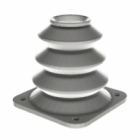3D printing environmental impact
As additive manufacturing gains global momentum, its environmental impact is being examined more closely than ever. While 3D printing is often viewed as a more sustainable alternative to traditional manufacturing, the reality is more nuanced. The technology brings clear advantages in terms of material efficiency and local production — but it also raises concerns about energy usage, material sourcing, and end-of-life waste. The overall footprint of additive manufacturing depends heavily on both the printing technology used and the energy source powering it. Life Cycle Assessment (LCA) studies show that renewable electricity and optimized post-processing can significantly reduce emissions compared to traditional methods. To understand its true footprint, we need to explore both the positive contributions and the negative environmental impact of 3D printing across different technologies and use cases.
Material efficiency vs. waste streams
One of the strongest environmental arguments in favor of 3D printing is its additive nature. Unlike subtractive methods — which cut away material to achieve a final form — 3D printing uses only what’s needed, layer by layer. This reduces scrap waste, particularly in metal and polymer-based manufacturing.
However, this doesn’t mean that 3D printing is zero-waste. In processes like SLS or SLA, unsintered powder and unused resin may not always be fully recyclable or reusable. Powders can degrade after multiple cycles, and resins may need filtering or disposal due to partial curing. In SLS printing, unsintered polyamide powder can typically be reused, but only up to a certain ratio — often 20–60% of fresh material must be mixed in each cycle. Over time, thermal aging and oxidation reduce powder flowability and alter part mechanical properties, limiting full recyclability. These unused materials often become waste unless tightly managed, especially in prototyping environments where turnaround is fast.
Energy consumption and emissions
The 3D printing impact on the environment also includes electricity usage — and that varies widely by technology. FDM printers consume modest amounts of power, similar to a desktop computer or microwave. But high-temperature industrial systems like SLS or DMLS require significant energy input to maintain chamber temperatures, operate lasers, and process parts. Over long production cycles, this adds up. Typical power consumption ranges from 50–250 watts for desktop FDM printers, 1–5 kilowatts for industrial SLS systems, and up to 10 kilowatts or more for metal DMLS printers. Additionally, post-processing operations — such as depowdering, sintering, or UV curing — can consume as much or more energy as the printing process itself.
Additionally, there are indirect emissions to consider — for instance, from thermoplastic off-gassing during high-heat extrusion, or from curing fumes in resin-based systems. These emissions are typically minimal in small setups but could become more problematic in poorly ventilated or large-scale print farms.
Read more: Do 3D printers use a lot of electricity?
Lifecycle and recyclability
The sustainability of 3D printed parts also depends on what happens to them after use. Many popular materials like PLA (a bioplastic) and PA12 (nylon) are technically recyclable, but not always in standard recycling streams. Although PLA is marketed as biodegradable, it requires industrial composting conditions — around 60°C and high humidity — to degrade effectively. In typical environments, its decomposition is extremely slow. Similarly, resin-based prints are thermoset polymers, meaning they cannot be remelted or reshaped, which makes their recycling particularly challenging.
That said, some companies are innovating in this space — offering closed-loop powder systems, compostable filaments, or take-back programs for material recovery. These solutions aim to close the loop, but they aren’t yet industry standard.
Transportation, supply chains & local manufacturing
On the positive side, 3D printing reduces environmental impact by decentralizing production. Rather than shipping parts across the globe, companies can print closer to the point of use. This reduces transportation emissions and allows for more on-demand manufacturing, which cuts down on overproduction and warehousing waste. Moreover, the concept of digital warehousing — storing 3D models as digital files rather than physical stock — enables on-demand, location-independent production. This drastically reduces inventory-related waste and obsolescence, especially in spare parts logistics and aerospace maintenance.
In sectors like aerospace, automotive, or spare parts logistics, the long-term sustainability gains of additive manufacturing are tied to this shift — minimizing material inventory and enabling digital distribution.
Key sustainability benefits
Despite its challenges, 3D printing offers real advantages from a sustainability perspective, especially when managed with best practices:
- localized production reduces carbon footprint of shipping,
- just-in-time manufacturing limits overproduction and storage costs,
- complex part consolidation can reduce material use and assembly waste,
- topology optimization and lattice structures allow significant material savings without compromising mechanical strength.
Challenges that remain
However, the technology is not free from criticism. The negative environmental impact of 3D printing can be seen in areas such as:
- energy-intensive industrial systems with long cycle times,
- non-biodegradable polymers and resins entering waste streams,
- limited infrastructure for recycling or reuse, especially in consumer markets.
Additionally, the lack of standardized life cycle assessment (LCA) metrics across additive technologies makes it difficult to compare their environmental performance objectively. More consistent methodologies are needed to evaluate true sustainability across different systems. This gap highlights the importance of ongoing research and transparent data sharing across the additive manufacturing industry.
Conclusion
Additive manufacturing offers real promise as a more sustainable manufacturing method, especially when applied thoughtfully and with long-term circularity in mind. To realize its full benefit, the industry must continue to innovate in material science, energy efficiency, and end-of-life management.
Ultimately, the environmental impact of 3D printing isn’t just about the technology itself — it’s about how it’s used. The path forward will depend not only on technological progress but also on responsible practices across the value chain — from sustainable material sourcing and renewable energy use to efficient post-processing and recycling systems. With smart design, closed-loop systems, and better material stewardship, 3D printing can shift from being a net burden to a net benefit for the planet.
Explore also
- Is 3D printing sustainable?
- 3D printing waste
- Is 3D printing bad for the environment?
- 3D print recycling
- Sustainable 3D printing materials
Related categories
 Austria
Austria  Bosnia and Herzegovina
Bosnia and Herzegovina  Bulgaria
Bulgaria  Croatia
Croatia  Czech Republic
Czech Republic  Denmark
Denmark  Estonia
Estonia  Finland
Finland  France
France  Germany
Germany  Greece
Greece  Hungary
Hungary  Ireland
Ireland  Italy
Italy  Latvia
Latvia  Lithuania
Lithuania  Poland
Poland  Portugal
Portugal  Romania
Romania  Slovakia
Slovakia  Slovenia
Slovenia  Spain
Spain  Sweden
Sweden  Switzerland
Switzerland  United Kingdom
United Kingdom  Ukraine
Ukraine  China
China  Hong Kong
Hong Kong  India
India  Israel
Israel  Japan
Japan  Malaysia
Malaysia  Philippines
Philippines  Saudi Arabia
Saudi Arabia  South Korea
South Korea  Taiwan
Taiwan  Thailand
Thailand  Turkey
Turkey  United Arab Emirates
United Arab Emirates  Egypt
Egypt  South Africa
South Africa  Tunisia
Tunisia  Canada
Canada  Mexico
Mexico  United States
United States  Brasil
Brasil  Colombia
Colombia  Australia
Australia  New Zealand
New Zealand 












